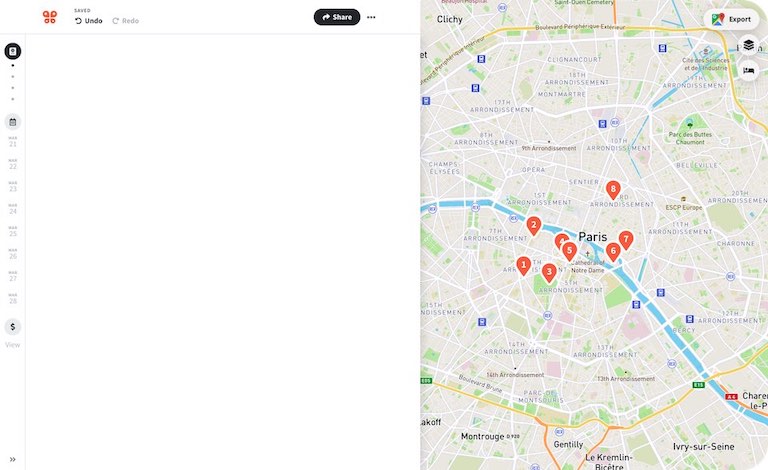里约热内卢的49个必做事项和景点
Navigate forward to interact with the calendar and select a date. Press the question mark key to get the keyboard shortcuts for changing dates.
Navigate backward to interact with the calendar and select a date. Press the question mark key to get the keyboard shortcuts for changing dates.
更新 • 更新10月 4, 2025






Navigate forward to interact with the calendar and select a date. Press the question mark key to get the keyboard shortcuts for changing dates.
Navigate backward to interact with the calendar and select a date. Press the question mark key to get the keyboard shortcuts for changing dates.
Navigate forward to interact with the calendar and select a date. Press the question mark key to get the keyboard shortcuts for changing dates.
Navigate backward to interact with the calendar and select a date. Press the question mark key to get the keyboard shortcuts for changing dates.
Navigate forward to interact with the calendar and select a date. Press the question mark key to get the keyboard shortcuts for changing dates.
Navigate backward to interact with the calendar and select a date. Press the question mark key to get the keyboard shortcuts for changing dates.

5糖面包山






8Lapa






11塞勒隆阶梯
12科帕卡瓦纳
14伊帕内玛
15Arpoador






20莱伯伦






24菲斯卡尔岛
25科尔科瓦杜






29佩德拉-达加维亚






31皇家葡文图书馆












41博塔弗戈
42拉各亚
44馬拉卡納區






46普赖尼亚
49Vidigal
从里约热内卢出发的热门公路旅行
在里约热内卢的天气怎么样?
这取决于您何时访问!我们收集了NASA的数据,显示里约热内卢每个月的天气情况:请查看下面的链接以获取更多信息。
从里约热内卢出发的所有公路旅行
- 从里约热内卢到圣保罗的驾车路线
- 从里约热内卢到布基亚斯的驾车路线
- 从里约热内卢到坎普斯-杜若尔当的驾车路线
- 从里约热内卢到贝洛哈里桑塔的驾车路线
- 从里约热内卢到帕拉地的驾车路线
- 从里约热内卢到库里提巴的驾车路线
- 从里约热内卢到安格拉杜斯雷斯的驾车路线
- 从里约热内卢到布宜诺斯艾利斯的驾车路线
- 从里约热内卢到格拉玛多的驾车路线
- 从里约热内卢到伊瓜苏的驾车路线
- 从里约热内卢到巴西利亚的驾车路线
- 从里约热内卢到弗洛里亚诺波利斯的驾车路线
- 从里约热内卢到Porto Seguro的驾车路线
- 从里约热内卢到乌巴图巴的驾车路线
- 从里约热内卢到欧鲁普雷图的驾车路线
- 从里约热内卢到萨尔瓦多的驾车路线
- 从里约热内卢到桑托斯的驾车路线
- 从里约热内卢到蒂拉登特斯的驾车路线
- 从里约热内卢到维多利亚的驾车路线
- 从里约热内卢到蒙得维的亚的驾车路线
- 从里约热内卢到Pocos de Caldas的驾车路线
- 从里约热内卢到Itatiaia的驾车路线
- 从里约热内卢到阿雷格里港的驾车路线
- 从里约热内卢到Natal的驾车路线
- 从里约热内卢到阿拉伊阿尔港的驾车路线
- 从里约热内卢到康泊琉海水浴场的驾车路线
- 从里约热内卢到福塔莱萨的驾车路线
- 从里约热内卢到圣塞巴斯蒂昂的驾车路线
- 从里约热内卢到坎皮纳斯的驾车路线
- 从里约热内卢到累西腓的驾车路线
探索附近的地方
所有与里约热内卢相关的地图
- 里约热内卢的地图
- Visconde de Maua的地图
- 尼泰罗伊的地图
- Duque de Caxias的地图
- Sao Goncalo的地图
- Nova Iguacu的地图
- Marica的地图
- 彼得罗波利斯的地图
- Guapimirim的地图
- Itaipava的地图
- 特雷索波利斯的地图
- Saquarema的地图
- Vassouras的地图
- Barra do Pirai的地图
- Araruama的地图
- 曼加拉蒂巴的地图
- Valenca的地图
- Nova Friburgo的地图
- Conservatoria的地图
- Volta Redonda的地图
- Vila do Abraao的地图
- Sao Pedro da Aldeia的地图
- 安格拉杜斯雷斯的地图
- Lumiar的地图
- 阿拉伊阿尔港的地图
- 卡布弗里乌的地图
- Juiz de Fora的地图
- 布基亚斯的地图
- Lima Duarte的地图
- Rio das Ostras的地图
- 雷森迪的地图
里约热内卢全年
在寻找里约热内卢的每日行程吗?
通过我们的精心策划的行程,为您的里约热内卢之旅获取灵感,这些行程每天都充满了热门景点!在这里查看:
附近城市的最佳景点
- 圣保罗的个必做事项和景点
- 贝洛哈里桑塔的个必做事项和景点
- 安格拉杜斯雷斯的个必做事项和景点
- 帕拉地的个必做事项和景点
- 乌巴图巴的个必做事项和景点
- 欧鲁普雷图的个必做事项和景点
- 布基亚斯的个必做事项和景点
- 尼泰罗伊的个必做事项和景点
- 彼得罗波利斯的个必做事项和景点
- 卡布弗里乌的个必做事项和景点
- 坎普斯-杜若尔当的个必做事项和景点
- 阿拉伊阿尔港的个必做事项和景点
- 蒂拉登特斯的个必做事项和景点
- Itatiaia的个必做事项和景点
- 特雷索波利斯的个必做事项和景点
- Nova Friburgo的个必做事项和景点
- 曼加拉蒂巴的个必做事项和景点
- Guapimirim的个必做事项和景点
- Marica的个必做事项和景点
- Araruama的个必做事项和景点
- Duque de Caxias的个必做事项和景点
- Conservatoria的个必做事项和景点
附近城市的最佳餐厅
- 圣保罗的家最佳餐厅
- 贝洛哈里桑塔的家最佳餐厅
- 安格拉杜斯雷斯的家最佳餐厅
- 帕拉地的家最佳餐厅
- 乌巴图巴的家最佳餐厅
- 欧鲁普雷图的家最佳餐厅
- 布基亚斯的家最佳餐厅
- 尼泰罗伊的家最佳餐厅
- 彼得罗波利斯的家最佳餐厅
- 卡布弗里乌的家最佳餐厅
- 坎普斯-杜若尔当的家最佳餐厅
- 阿拉伊阿尔港的家最佳餐厅
- 蒂拉登特斯的家最佳餐厅
- Itatiaia的家最佳餐厅
- 特雷索波利斯的家最佳餐厅
- Nova Friburgo的家最佳餐厅
- 曼加拉蒂巴的家最佳餐厅
- Guapimirim的家最佳餐厅
- Marica的家最佳餐厅
- Araruama的家最佳餐厅
- Visconde de Maua的家最佳餐厅
- Vassouras的家最佳餐厅
- Saquarema的家最佳餐厅
- Nova Iguacu的家最佳餐厅
- Duque de Caxias的家最佳餐厅
- Sao Goncalo的家最佳餐厅
- Conservatoria的家最佳餐厅
- Barra do Pirai的家最佳餐厅
- Trindade的家最佳餐厅
- Itaipava的家最佳餐厅

- 行程和地图一览
- 实时协作
- 自动导入酒店和预订
- 优化您的路线
- 手机离线访问
- 优化您的路线
- 查看所有地点之间的时间和距离
 餐厅
餐厅 景点
景点 咖啡馆
咖啡馆 拍照点
拍照点 便宜的食物
便宜的食物 早餐和早午餐
早餐和早午餐 面包店
面包店 酿酒厂和啤酒
酿酒厂和啤酒 浪漫的地方
浪漫的地方